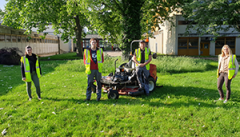
Life on campus
LyonTech-La Doua: the new ‘green lung’ of locked-down Villeurbanne
On the LyonTech-La Doua campus, nature goes on living and thriving under the watchful and benevolent eye of Loïs Guillot, director of the inter-university la Doua estate department (SIDD). Flowering, the felling of trees affected by canker stain and the monitoring of building sites and development projects make up the busy daily life of the young woman living on campus. Story.
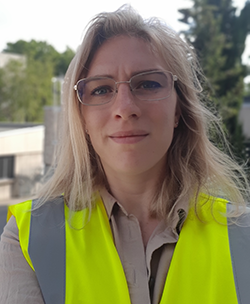 It is no longer students but families with young children who give themselves a breath of fresh air on the ‘green road’, using pebbles as natural seating. It is no longer professors riding their bicycles on the track but fathers, on bicycles or on foot, who give themselves a breath of fresh air across the campus. Since lockdown has kept the usual users away from the LyonTech-la Doua site, another audience has been revealed on these hectares shared by Lyon 1 University and INSA Lyon. Being unable to get to the Tête d'Or or Feyssine parks, some walkers in search of a breath of fresh air for a specified period of time and distance have found an alternative within a stone's throw of their homes.
It is no longer students but families with young children who give themselves a breath of fresh air on the ‘green road’, using pebbles as natural seating. It is no longer professors riding their bicycles on the track but fathers, on bicycles or on foot, who give themselves a breath of fresh air across the campus. Since lockdown has kept the usual users away from the LyonTech-la Doua site, another audience has been revealed on these hectares shared by Lyon 1 University and INSA Lyon. Being unable to get to the Tête d'Or or Feyssine parks, some walkers in search of a breath of fresh air for a specified period of time and distance have found an alternative within a stone's throw of their homes.
This was a strange feeling for Loïs Guillot, director of the inter-university la Doua estate department. Living on site, her garden is the huge la Doua estate, which she has looked after since her first day on the job. Vegetation, plants, landscaping, restoration and construction hold no secrets for this nature lover, who watches over the campus like a chef watches over the cooking of his dishes. Even in this period, which has forced the whole population to live in isolation. She is only physically isolated. For seven weeks now, she has been monitoring the site, liaising with companies, managing building sites and keeping up with records, and admits to receiving many phone calls and more emails than usual. As the first spectator of nature that unfolds to its full potential, she observes a campus now in bloom, far from the popular student use it normally sees at this time of year: spring, festivals and post-exam celebrations.
But there is a danger lurking, and it has hit hard this year. A serious disease, caused by a fungus classified as a pest of mandatory control. To date, no effective means of control has been found, obliging the reporting of any contaminated subject and the implementation of control methods at any time and in any place. This incurable disease, a real scourge for plane trees, appeared in France in 1945, when American troops landed in Provence. The wood from their ammunition boxes allowed the introduction of the parasite responsible for this disease, canker stain. Although Vaucluse and Bouches-du-Rhône are the departments most affected, the disease is spreading and causes thousands of plane trees to be felled throughout France every year.
When the symptoms appeared on the plane trees on campus, Lois knew it was already too late. The canker had already begun to destroy its hosts a few years ago, making the verdict final. They would have to be culled, after verification of the diagnosis and establishment of the procedure applied by prefectural order. Several plane trees are affected at the extremities of the site, in the ENSSIB car park and in front of the INSA heritage department. This iconic campus pathway, which runs along the first-year student accommodation blocks, will thus lose some of its lustre. In one week in May 2020, in the midst of the lockdown imposed in the fight against the spread of COVID-19, eighteen diseased plane trees were felled to prevent another disease from spreading and killing other trees in the surrounding area. The image is strong and the parallel brings its share of dreams.
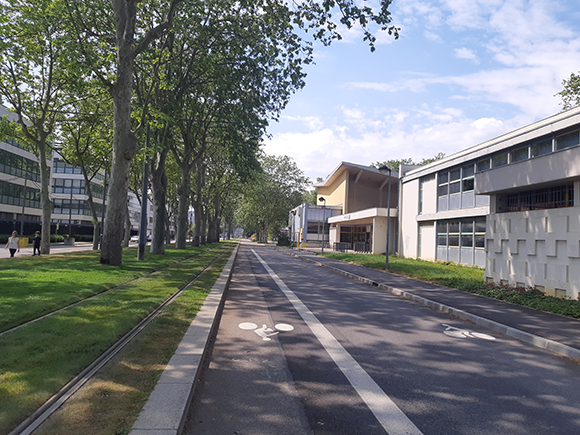
Loïs was present at the operation, which was scrupulously carried out by specialists in full protective clothing. She watched as these trees were taken almost entirely to the burning platform, leaving behind them the mark of their hold on the ground and part of their roots, which cannot be completely removed. The contaminated land cannot be used for planting new species. It bears the stigma of the felling and will bide its time, supported by archive photos.
A new look is being considered for the site. On the horizon is a State-Region development plan in which Loïs will be involved, to propose a green setting consistent with the project. The area is very sunny, it is very hot in the summer. In the meantime, she can't help but think of the students who have been locked down in their 9 m2 room. Even if they can go out for an hour a day on a campus in the middle of nature, the time must seem long to them.

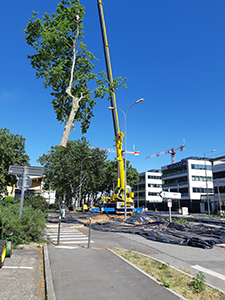
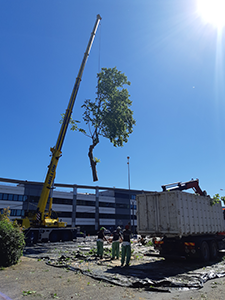
The recovery is still hazy, for them as for her. But just like trees whose flowers are beginning to bud, and this nature that unfolds in spite of everything, life goes on, and can sometimes reinvent itself.
Team photo - from left to right: Cindy Maleysson, administrative assistant at SIDD, Lucas Feront and Guillaume Maistre-Bazin, two gardeners on duty during lockdown, and Loïs Guillot, director of SIDD
Keywords (tags)
News list
Une délégation de haut niveau de l’Université Beihang reçue à l’INSA Lyon

